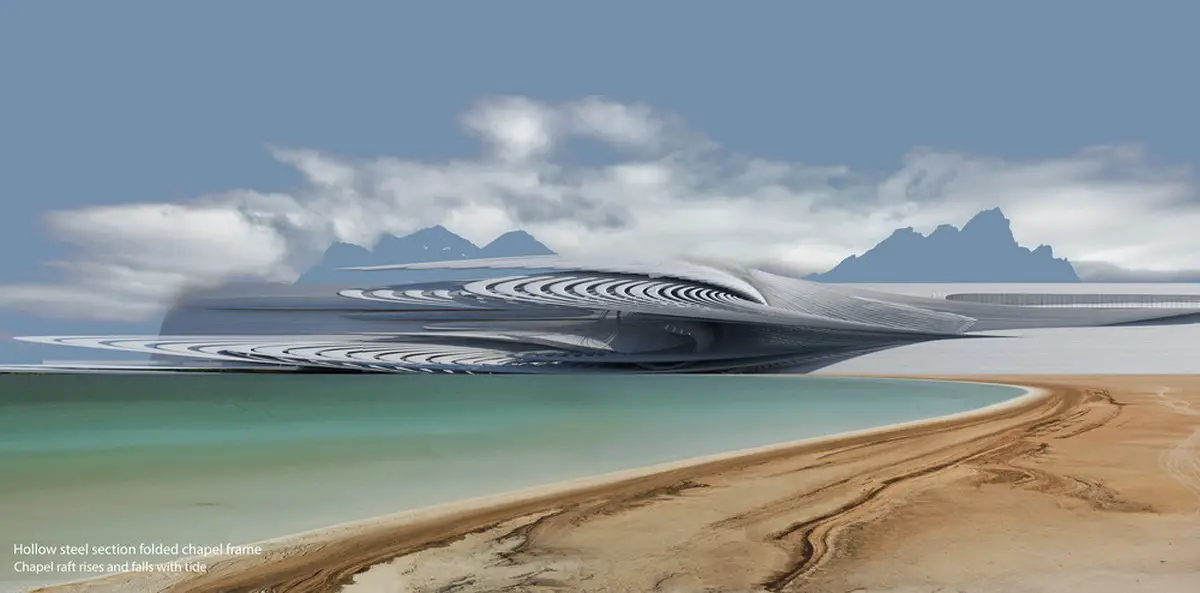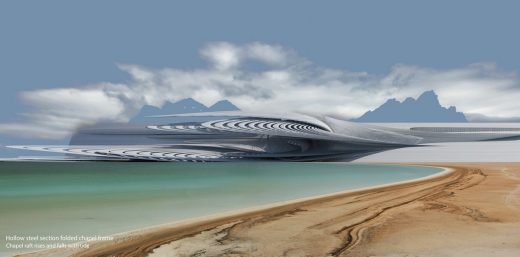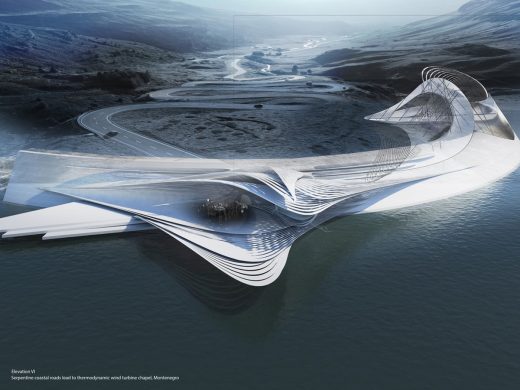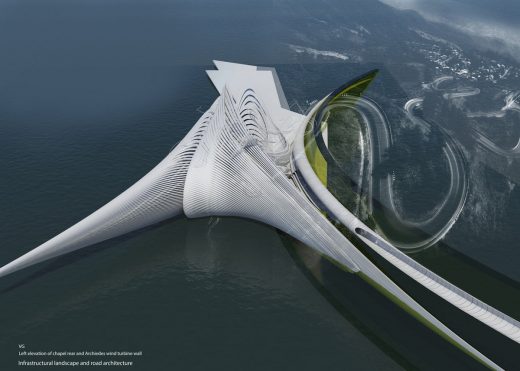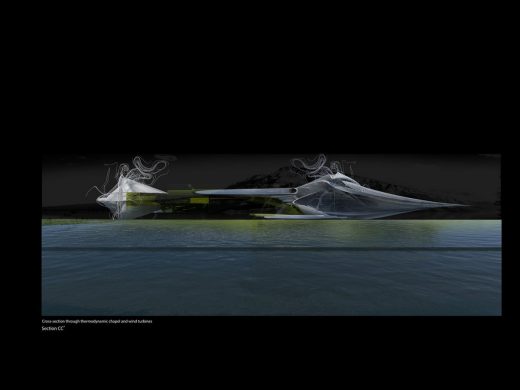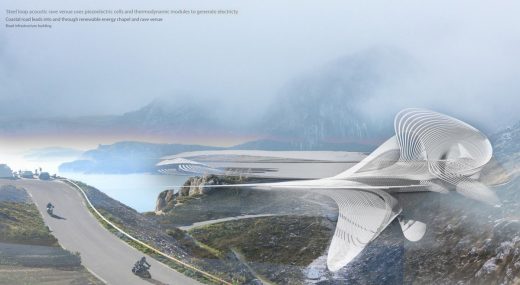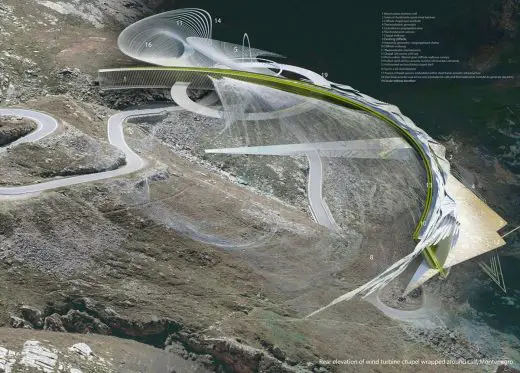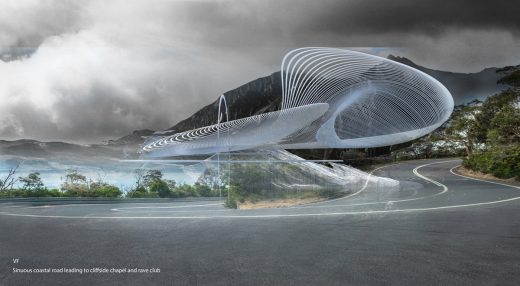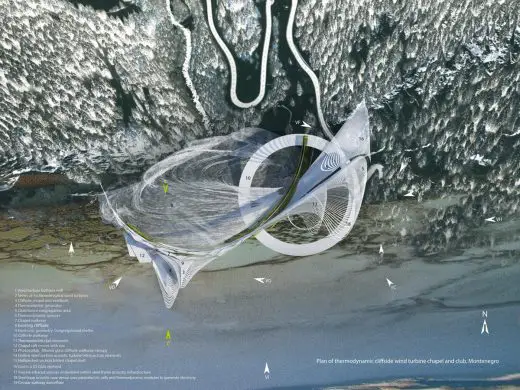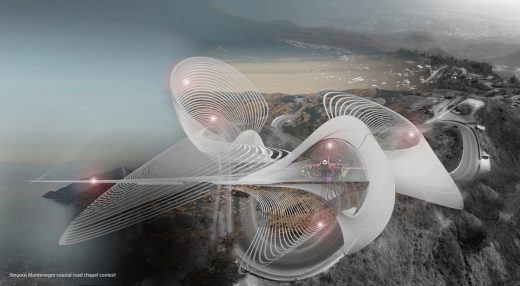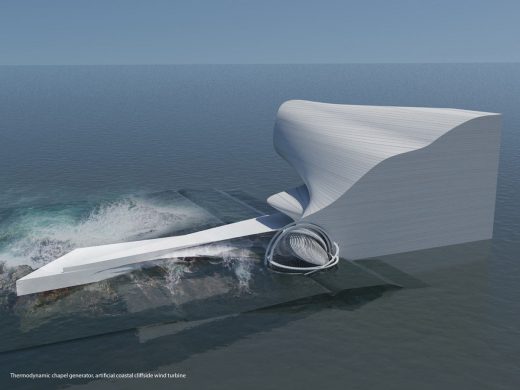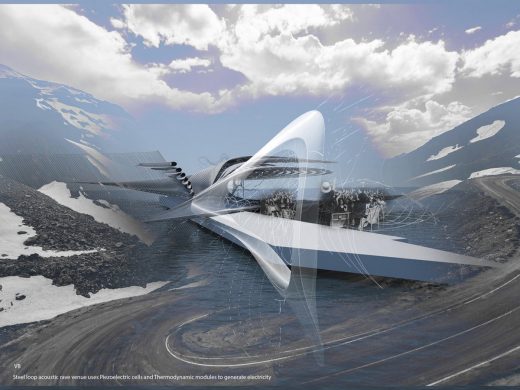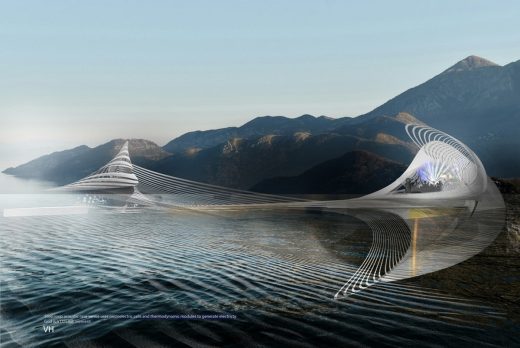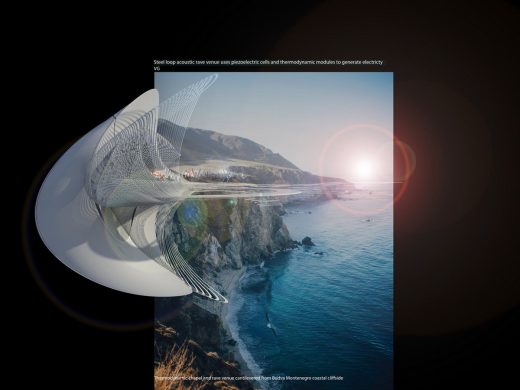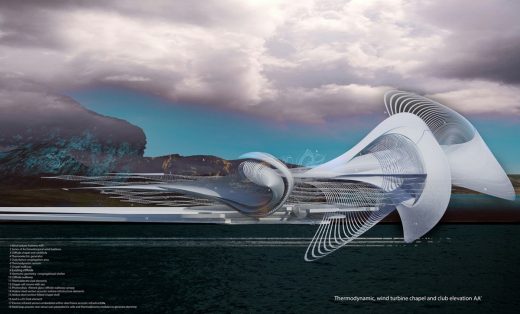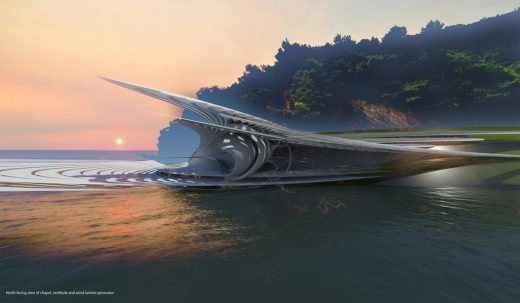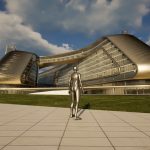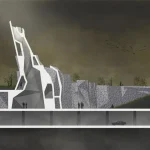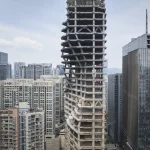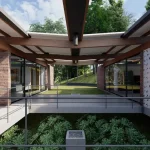Thermodynamic Wind Turbine Chapel and Club, Montenegro concept building, architecture images, Citizens counter services
Thermodynamic Wind Turbine Chapel and Club in Montenegro
22 May 2024
Design: Margot Krasojević Architects
Location: Medjurecje, Montenegro
Images: Dr.Margot Krasojević
Thermodynamic Wind Turbine Chapel and Club
Margot Krasojević Architects proudly unveil a project to deliver renewable energy to worshipping communities in a newly-designed cliffside chapel in Montenegro.
Montenegro has an ancient history of religion and politics, and many Orthodox Christians retreated to the mountains in the 1600s to escape the Ottoman Empire. That exodus was repeated during the subsequent great wars and, today, it is a thriving tourist and mining-based country marked by numerous unexcavated mountain tunnels that are shortcuts towards the Adriatic Sea.
The Pilgrimage to Ostrog, one of Montenegro’s most famous cliffside churches, is still being undertaken today. Montenegro has a varied and, at times, treacherous and dangerous landscape; the country borders Serbia and Albania and has vertiginous mountain ranges, dense dark forests, mountain plains, valleys (canyons and gorges), and basins; a dynamic physical geographic basis and strip of the Adriatic coast. Tourists, worshipers, and families visit yearly, with most driving into one of several coastal towns for vacations. However, the dangerously sinuous roads are responsible for many accidents and deaths, with several shrines dotted along them as a reminder. The country is steeped in harrowing tales of bloodshed etched into the landscape.
The cliffside project undertaken by Margot Krasojević Architects respects the region’s natural beauty, but also considers the tough and inhospitable landscape, suggesting a more aggressive, dynamic approach to the design. Montenegro has a prevailing wind called Bora, fastest at the highest peaks, embracing the cliffsides by running along them. The project site is a disused, partly constructed tunnel with the retaining cliff walls built. Located between Kotor and Budva, the project combines the summer music festivals and raves popular in the area with a chapel as a type of renewable energy gathering—a congregation.
The prevailing Bora wind can reach 100 mph at the highest latitude, and the architecture choreographs the wind through the wind turbine channelled walls. The wind turbines are positioned in series to accelerate the speed when passed through differing cross-sections within the chapel design, increasing speed and efficiency. The building uses Archimedes spiral turbines, as they are more resilient and better suited for the Montenegrin environment’s characteristics. These turbines are less complicated to lean and are weighted differently to minimize backwind interference between the turbines, which can slow down and prevent maximum energy output.
The church embraces the idea of a congregation, a gathering of people to unite for self-expression and worship, echoing nearby raves and music festivals held along the coast, as well as Ostrog Cliff Church. The concept is to design spaces and platforms to bring people together using their kinetic movement and heat to generate electricity by employing thermodynamics and piezoelectricity along with wind energy, bringing sustainability from renewable energy to the remote areas of Montenegro. At times, the treacherous landscape with vertiginous heights can be unwelcoming to occupy. However, with a strong sense of history and community, the landscape has become more welcoming thanks to the thermodynamic wind turbine chapel venue, given that surplus energy generated is used to light up the dangerously curved roads that lead drivers to the Adriatic Sea from other nearby cities.
The typology of the chapel focuses on renewable energy and congregation. Worship, music, and dance come together in one building. The building unfurls from the cliffside, similar to the Bora wind, with the chapel connected to the music venue by a cliff walkway along the spiral wind turbine channels. The chapel uses hollow steel pipes wrapped around the vestibule containing the wind generator. The entire section is sculpted, folding out from the wind turbine walls. The rave club is composed of looped steel sections mimicking the soaring mountains of Montenegro; cross sections dive and rise out of the cliffside, breaking through the mountain like a beacon of light, and guiding drivers toward the sea.
The architecture uses thermoelectric materials, including conducting polymers, to convert thermal energy into electrical energy when exposed to temperature increase. The polymer is more adaptable and geometrically flexible, which is necessary for the building’s intricate geometry. The chapel and rave club’s congregation generates enough heat energy to produce electricity. This thermoelectric effect is often associated with the piezoelectric effect and exploited for pyroelectric infrared temperature detectors. Gallium nitride, a semiconductor, is most commonly used as a pyroelectric crystal, similar to piezoelectric cells that can be applied to building materials and cladding to enable the semiconductors to detect temperature and pressure changes, which produces a voltage to generate an electrical charge stored like a capacitor when needed. The club’s circular walkway dancefloor utilizes piezoelectric cells to generate an electrical charge. The architecture, coastal roads, and mountains illuminate when the chapel and club congregate.
The building’s plan comprises three design areas: the chapel, the wind turbine wall, and the club/generator, using the principles of a wind organ and fluid dynamics to choreograph the prevailing Bora wind throughout the scheme. The building geometrically looks like it has captured wind movement, crystallising it mid-shift to reveal what is unseen, yet felt.
Thermodynamic Wind Turbine Chapel and Club in Medjurecje, Montenegro – Building Information
Architects/Designers: Margot Krasojević – https://www.margotkrasojevic.org/
Official name of the project: Thermodynamic wind turbine chapel and club
Location: Montenegro, Kotor
Client: SHANGHAIMETAL
Project manager: Margot Krasojević
Collaborators: Out to tender
Thermoelectric materials
Thermoelectric materials, like conducting polymers, convert thermal energy into electrical energy when exposed to temperature increases. Gallium nitride, a semiconductor, is used as a pyroelectric crystal. Semi-conducting materials applied to be confirmed.
Piezoelectric cells
Piezoelectric cells are embedded in dance floor mats, PIEZO, Chinese production.
Composite carbon fibre
Composite carbon fibre reinforced Polymer composite interior vaulted shell cladding. Elite Carbon Fibre manufacturers, U.k/Beijing
Anti-vibration vacuum bagged composite fibre shell insulation
Placed between interior and exterior frame.
Epoxy laminate molds for fibreglass construction.
Pressure sensitive tapes for brake testing facility- Matrix composites, U.K./Beijing
Technical textiles
Technical textiles applied to inner lining of cantilever cladding, lighter than aluminium for weightlessness and resilience. Textile fibre materials determine stability through 45 degree torsions for track expansion. The material adapts to the external forces of the cantilever and its movement.
Carbon fibre
Carbon fibre reinforced plastics allow for complex shapes more than steel or aluminum. weight saving. resin saturated cured elements, achieving lower weight for the cantilever.
7. 3m optical mirror film, light transmission. polymer film exhibits 99% light reflectance for interior and exterior cladding elements used in viewing tunnel and atrium surfaces.
Interior materials
Polyester films transform between transparent and translucent states dependent on viewing angles, anti-reflective privacy films.
Self healing polymers
Self healing polymers are used to support internal mechanisms, sliding seamless surfaces and load transfer attachments between skin and skeleton of expanding race track. This structural deformity under load catering the telescopic composite fibre sections has a series of polymer sheets which protect the design from wear and tear as the tracks slide apart to reveal the atrium.
Motion capture system
A motion capture system between the primary and tertiary structure record the movements of vehicles, which allows the facility to virtually synchronize with vehicle movement and performance.
Light transmission
Light transmission is very important in the viewing tunnels and barrel-vaulted facility which is why acrylic is beneficial to the design along with PLEDS, enabling thin lighting displays with superior effect and simplicity to LCD’S. These Polymer Light Emitting Diodes are also used in the surrounding landscape of the proving ground to transform the interior environment as necessary.
Telescopic track shell sections
Telescopic track shell sections are lined with composite carbon fibre impregnated with epoxy resin.
Brake measurement tracks
Surfaces include asphalt, tile, polished basalt, concrete aquaplaning basin/hydroplane.
Inflatable manoeuvring kerb strike installation
Kerb facilitates shallow angle strikes and steering ‘jacking’ off the kerb. Located around the race track and crash zone.
1KM elevated Sine wave track for vehicle inspection
About Margot Krasojević
Margot Krasojević completed her architectural education at the Architectural Association School of Architecture and The Bartlett, University College London. She worked with Zaha Hadid Architects and was a lead undergraduate and master’s studio director, investigating digital and sustainable design programs at UCL, University of Greenwich, UWA, and the University of Washington. She then opened a multidisciplinary architectural design studio focusing on integrating environmental issues, renewable energy, and sustainability as part of the design process.
Ms. Krasojević is currently working on projects in Asia, where she is integrating and harnessing renewable energy as part of a building service infrastructure. She is also designing hydroelectric homes and hotels which redefine the manner in which not only tourism but everyday rituals are affected.
Ms. Krasojević believes that a cross-disciplinary design strategy is very important for architecture proposing new typologies, which reflect our perpetually changing environment. She focuses on design criteria that involve renewable energy sources and technology to develop a formal and structural architectural language, supported by dynamic simulation software.
Ms. Krasojević won the 2018 LEAF Award for “Best Future Building – Under Construction and Drawing Board” for her “Self-Excavation Hurricane House” in Louisiana, US, and her `Hydroelectric House’ design is a permanent exhibit at The Futurium, Berlin, opened 5th September 2019. The Turbine hotel has been featured as part of a television documentary by RAUM Films, Austria.
Ms. Krasojevic was nominated for the Energy Globe awards 2020, and she won GOLD WAN awards in 2020 and 2021, Belgrade Design Week for recyclable materials research. Her work has also been exhibited as part of Exhibition at the Smithsonian, Alaska, 2021, Green Building Symposium, Czech Republic, 2021, and Design Museum, London. September 2023. Ms. Krasojevic also served as a WAN judge 2023.
Margot Krasojević is currently working on 3 hotel design projects in Saudi Arabia in collaboration with NEOM. She is also the author of “Dynamics and Derealisation” and “Spatial Pathologies-Floating Realities”, and is a visiting professor at the University of Washington.
Renders: Dr.Margot Krasojević
Thermodynamic Wind Turbine Chapel and Club, Montenegro images / information received 220524 from v2com newswire
Location: Medjurecje, Montenegro, southeast Europe
Montenegro Architecture
Montenegro Architecture Designs – chronological list
Montenegro Building design by Rifat Alihodzic on e-architect:
Gasulhana, Hatme & Mevlud Central Building, Bijelo Polje
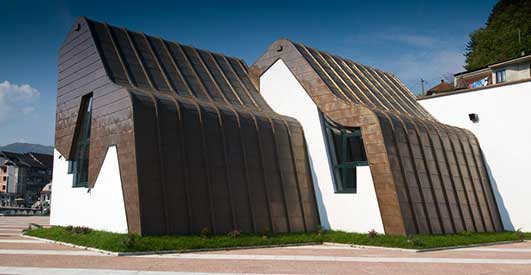
image from architects
Montenegro Architectural News – recent architectural selection on e-architect:
House In The Field
Design: Arhimetrija, architects
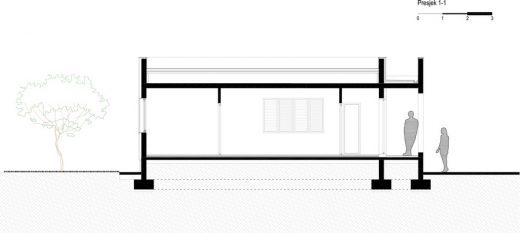
image from architects
House In The Field
Porto Montenegro
Design: ReardonSmith Architects
Montenegro Luxury Resort
Design: Make architects
Lido Mar Porto Montenegro
Design: Studio RHE
Nursery School Building Designs
Comments / photos for the Thermodynamic Wind Turbine Chapel and Club, Montenegro concept building design by Margot Krasojević Architects page welcome

